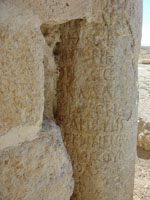 MAMA XI 310 (Perta)
MAMA XI 310 (Perta) 
Imperial grant, perhaps of fiscal immunity
- Type of monument:
- Imperial grant, perhaps of fiscal immunity.
- Location:
- Koçaş (Perta): in the steps of a house.
- Description:
- Greyish marble column with remains of a moulding at the top, buried below.
- Dimensions:
- Ht. 1.00+; Diameter 0.48; letters 0.045-0.055.
- Record:
- Squeeze; MB notebook copy (1956/162).
- Publication:
- Callander and Ramsay 1909.
- Date:
- Sixth or seventh century AD.
†
θεία προνομία φιλοτ̣[ι]μ(ηθέντα)
παρὰ τῶν θεοφυλάκτ(ων)
ἡμῶν δεσππο(τῶν) διὰ Καλλι-
νίκου τοῦ ἐνδοξ(οτάτου) ἀπὸ ὑπάτ(ων)
5τοῖς τὴν Περτέων οἰκοῦσι
πόλιν.
†
Line 1: θείᾳ προνομίᾳ Callander and Ramsay.
The divine privileges granted by our Lords, defended by God, through the offices of Kallinikos, the most splendid (gloriosissimus) honorary consul, to those inhabiting the city of the Perteis.





An identical second copy of this text was seen by Ramsay at Obruk Han (Callander and Ramsay 1909: 8) and subsequently published as MAMA VIII 270. As noted by Robert, Hellenica XIII, 61-2, the Obruk copy had already been copied by Zimmerer in 1897 and published by Th. Preger in 1899 (Oberhummer and Zimmerer 1899: 303-10, no. 11 [non uidi]). The physical form and dimensions of the Obruk stone are identical to those of the Koçaş monument (round column with plain moulding above; Ht. 1.80+; diameter 0.47; letters 0.050-0.060); two photographs of the Obruk monument were published by Robert, Hellenica XIII, Planche XXII, nos. 4-5; it was still visible in March 2011 (see photo below).
It is not at all clear what the ‘divine (i.e. imperial) privileges’ granted to the city of Perta might have been. The existence of two near-identical copies of the text inscribed on columns strongly implies that the stones themselves were intended to mark the spatial limits of the privileges concerned. The terminology of the grant (φιλοτιμηθέντα παρὰ τῶν... δεσπότων) is very similar to that employed in sixth-century imperial grants of asylum to churches in the eastern Roman provinces: cf. e.g. SEG 40, 1171, from Pontic Komana (BE 1992, 619: AD 582-90): ὅροι ἀσυλίας τοῦ εὐαγοῦς μοναστηρίου... φιλοτιμηθέντες παρὰ τῶν εὐσεββ(εστάτων) ⟨βασιλέων⟩ ἡμῶν Μαυρικίου Τιβερίου καὶ Κονσταντίνης. For other such asylum-horoi, cf. RECAM II 207-8 (Çiftlik, N. Galatia: Justinian I); Justinianic asylum-horoi from Pontos, Galatia and Syria are collected by Amelotti and Zingale 1985: 132-5. The phrase τὰ φιλοτιμηθέντα is also regularly used in the sixth and seventh century for cash grants (Sodini 1998: 624-5, no.1: finance for an aqueduct at Cypriot Salamis, AD 609-10: [ἐγένο]ντο σὺν θ(ε)ῷ κ(αὶ) αὗται ἑ εἱπτὰ ἁψῖδες ἐκ τν φιλοτιμηθέντων παρὰ Φλ. Ἡρακλίου) and other fiscal concessions (IG X 2, 1, 24: Thessalonike, AD 688: θεία δωρεὰ φιλοτιμηθεῖσα τῷ ἁγίῳ καὶ πανενδόξῳ μάρτυρι Δημητρίῳ παρὰ τοῦ τῆς ὅλης οἰκουμένης δεσπότου Φλ. Ἰουστινιανοῦ... τῆς ἁλικῆς τῆς θεοφυλάκτου ἡμῶν πόλεως Θεσσαλονίκης).
The horos marker from Komana (SEG 40, 1171) is very similar in form to the two stones from Perta (cylindrical column with upper moulding, Ht. 1.00, diameter 0.38, letters 0.030-0.050), perhaps suggesting that the two Perta inscriptions were intended to serve a similar function. It is conceivable that the stones are marking the grant (or rather, the restoration) of city-status to Perta; the term προνόμια is in fact used precisely of the possession of a civic constitution in Theodoret, Hist. Eccl. 5.19: ταῦτα πυθόμενος ὁ βασιλεὺς... τά τε τῆς πόλεως [Syrian Antioch] ἀφείλετο προνόμια καὶ τῇ γειτνευούσῃ πόλει τὴν ἡγεμονίαν δέδωκε (AD 387). In this case the stones would be marking the territorial limits of the city’s ἐνορία, within which the city possessed fiscal αὐτοπραγία. However, the wording of the inscription clearly implies that Perta was already a πόλις at the point when it was granted its προνόμια. It is perhaps more likely that Perta has been granted complete tax-exemption on at least a part of its territory (as granted in AD 533 by Justinian to the city of Didyma/Justinianopolis: Feissel 2004, esp. 316-7); the two stones would in that case be marking the limits of the territory exempt from taxation. All of this is, however, highly speculative.
On the ethnic Περτεύς in line 5, see the commentary to MAMA XI 307 (1956/159a), in which the city’s ethnic is given as Περτηνός. The honorary consul Kallinikos (PLRE IIIA 265, Callinicus 11) cannot be securely identified with any other bearer of that name. In an addendum to Callander and Ramsay 1909 (CR 23, 1909, 82), Ramsay suggested (following Dessau) that he might be identical to the Kallinikos who was praeses of Cilicia Secunda under Justinian I (PLRE IIIA 260, Callinicus 1), but there are no positive arguments to support this.